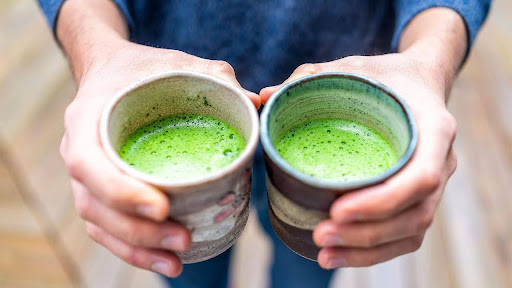Bin Matcha is a great inexperienced tea powder made from carefully-colored‑grown tea leaves. Renowned for its bright green coloration, clean flavor, and health advantages, Bin Matcha holds a special region in Japanese tea tradition.
Why Bin Matcha Stands Out
- Fine Cultivation – Grown underneath color for numerous weeks, this encourages the leaves to increase more amino acids (theanine), resulting in a sweeter, richer taste.
- Fine floor Powder – Made with the aid of milling dried tea leaves into a silken powder the usage of conventional stone turbines, making sure smoothness and minimal bitterness.
- Cultural heritage – often used in tea ceremonies, this tea displays centuries of Japanese subculture.
- Health blessings – packed with antioxidants, nutrients, and the calming amino acid L‑theanine.
How Bin Matcha Is Made
1. Shading the Tea Plants
- Tea plants are shaded about 3–4 weeks earlier than harvest.
- This technique will increase chlorophyll and theanine even as reducing bitterness.
2. Harvesting the Leaves
- Handiest, the youngest, most up to date leaves are picked—typically referred to as “first flush.”
3. Steaming and Drying
- Leaves are steamed (to save you oxidation), then lightly dried to preserve coloration and vitamins.
4. Stone‑Milling
- Dried leaves are floor slowly right into a satisfactory powder. The conventional stone mill helps hold aroma and texture.
How to Prepare Bin Matcha
Ingredients
- 1 teaspoon (2 g) Bin Matcha powder
- 3–four oz (ninety–120 mL) hot water (temperature: approximately eighty °C)
Tools (optional but helpful)
- Matcha bowl (chawan)
- Bamboo whisk (chasen)
- Sifter
Step‑by‑Step Instructions
Sift the Powder
- Sifting eliminates clumps and ensures smoothness.
Add Hot Water
- Avoid boiling water to save you bitterness.
Whisk Quickly
- Use an “M” or “W” movement till a light foam seems atop the tea.
Enjoy Immediately
- Matcha has to be consumed right away for the excellent taste and freshness.
Ways to Enjoy Bin Matcha
- Conventional Tea – pure and aware sipping revel in.
- Matcha Latte – blend with heat milk (dairy or plant-based totally) and a touch sweetener.
Culinary Use:
- Add to smoothies or oatmeal.
- Use in baked items like desserts, cakes, or cookies.
- Blend into savory sauces or dressings for a completely unique twist.
Health Benefits at a Glance
- High in antioxidants (catechins), in particular EGCG, which can also help immune features.
- Herbal power improves from caffeine, balanced via calming L‑theanine.
- Promotes relaxation, recognition, and a stronger mood.
- Supports metabolism and might be a useful resource in weight control.
- Gives vitamins and minerals such as vitamin C, nutrition A, and iron.
Tips for Choosing Good Bin Matcha
- Look for bright, colourful green coloration—a sign of freshness and high-quality.
- Take a look at for a clean, best texture—coarse or stupid matcha might also taste bitter.
- Purchase sparkling—matcha is touchy to mild, air, and moisture, so sealed, hermetic packaging is satisfactory.
- Taste—high‑high-quality powder tastes obviously sweet with subtle umami notes; keep away from overly grassy or sour powders.
Step-by‑Step: Using Bin Matcha in Baking
- Measure carefully – normally 1 to 2 teaspoons for a popular recipe.
- Sift Into Dry elements – facilitates preventing lumps in batter.
- Combine gently – Stir in liquid elements and bake as normal.
- Balance Flavors – The earthy taste pairs properly with vanilla, almond, or zesty citrus.
Common FAQs
Q1: What does “Bin” mean in Bin Matcha?
“Bin” refers to a specific place or manufacturer recognized for extremely good matcha fine—that specialize in exceptional way of life and meticulous processing.
Q2: Is Bin Matcha safe for children?
Sure, in moderation. It has lower caffeine than coffee and includes soothing L‑theanine, however it’s pleasant to restrict consumption.
Q3: How should I store Bin Matcha?
Maintain it in a cool, dark area in sealed, hermetic containers. For longer freshness, a few even store it inside the refrigerator (sealed tightly to keep away from moisture).
Q4: Can I drink Bin Matcha daily?
Truely—just preserve caffeine sensitivity and universal dietary stability in thoughts. Many enjoy one to two cups consistent with the day.
Q5: Why is my matcha bitter?
Possible motives:
- The water turned too hot.
- You used too much powder.
- The matcha is stale or low fine.
Correcting those can enhance flavor appreciably.
Conclusion
Bin Matcha is greater than simply powdered green tea—it encapsulates lifestyle, first-rate, and health. Its vibrant shade, smooth umami flavor, and wealthy nutritional profile make it a standout. Whether you’re sipping it instantly, making a comforting latte, or getting innovative inside the kitchen, this tea elevates ordinary moments with beauty and healthful advantages.








